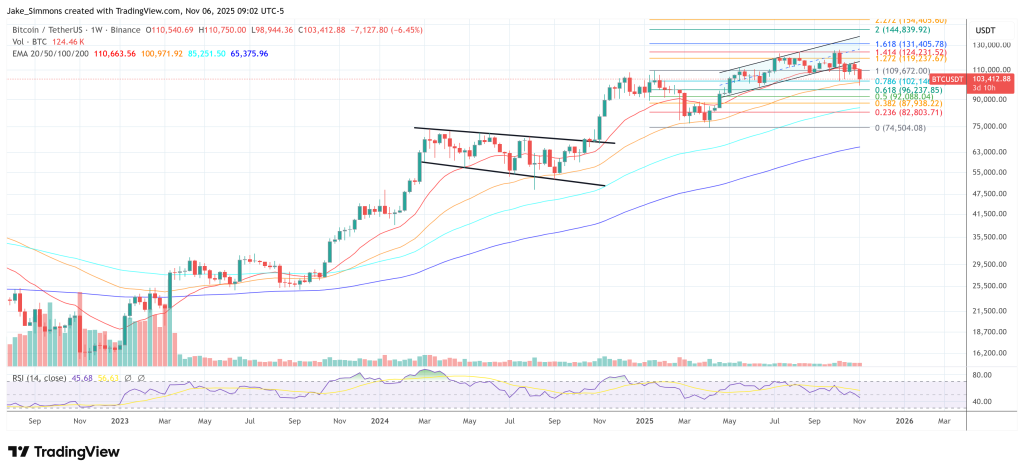A day after another billion-dollar liquidation cascade, veteran crypto analyst Trader Mayne says his core thesis is unchanged: the bull cycle’s top is “not in,” and the market is in the process of printing a weekly cycle low that could set up one more leg higher into year-end. “I’ve been banging on the drum about the high not being in,” he said in a November 5 video, adding that he remains “a BTC maxi from the spot perspective,” despite tactical longs and shorts that have been hit-and-miss during the recent volatility.
Is The Bitcoin Bottom In?
Mayne framed the selloff—coming less than a month after an almost $20 billion wipeout on October 10—as a feature, not a bug, of late-cycle price discovery. He argued that speculative leverage rapidly re-accumulated in altcoins and that majors still offer sufficient volatility with clearer structure. “People were right back on with the leverage… You really can’t teach an old dog new tricks,” he said, while emphasizing he now “primarily focus[es] on the majors” and holds a core spot stack he hasn’t sold.
His near-term timing anchor is cycle theory. Drawing on the four-year template popularized by Bob Loukas, Mayne said he expects the broader crypto top to land between late 2025 and early 2026, but he stressed the immediate setup is about nailing a weekly low within a narrow window that “extends until about mid next week, November 10.”
He wants to see “time and space away from this low” and a reclaim of the monthly open around $110,000–$112,000 to confirm that the decline has been exhausted. If that structure forms, he intends to treat $98,000 as the operative bull-market invalidation on a weekly-closing basis: “That will confirm to me that this is our bull market invalidation… at least in the worst case you have a cut point at like $100k Bitcoin.”

Mayne supplemented the timing view with a cross-asset read that he says has been reliable in prior impulses: gold tends to rally first, with Bitcoin following “about 60 to 90 days later.” He cited chart work showing gold’s advance now roughly 80–90 days old, which, if the relationship holds, would “line up very well with Bitcoin being ready to make its next move.” He also expects the BTC-versus-gold cross to bounce, implying outperformance of Bitcoin over the precious metal through year-end: “I’m pretty confident this chart is due for a big bounce and we’re going to see gold underperform Bitcoin for the remainder of the year.”
A more subjective—but, in his telling, telling—input is the absence of a true “blow-off” in Bitcoin versus the vertical arcs seen in AI-heavy equities and gold. With megacaps like Nvidia running hard since the spring and gold printing a sharp leg higher, he argued that “it just doesn’t sit right… that Bitcoin hasn’t had [its blow-off],” suggesting latent upside energy remains to be released if the weekly low locks in.
On market microstructure and seasonality, Mayne pointed to early-month dynamics. In many green months, he said, the low forms in the first third of the month, analogous to how Monday’s range often frames the week for intraday traders. If November is destined to close higher, an early-month low coupled with a monthly-open reclaim would be consistent with his cycle read. “If we’re bullish for November… I want to be a bull above the monthly open,” he said.
The scenario analysis was not one-sided. Mayne repeatedly acknowledged bear signals that have emerged on higher timeframes, including a weekly structure break, prior sweeps on the weekly and monthly, and building momentum divergences.
He warned of the possibility that the recent range resolves as distribution—“maybe the banks literally came in… and they’ve just been distributing on us here”—and laid out a lower-high path in which a rally fizzles beneath or just above the prior peak before breaking down. “There’s a world where we make an all-time high, but it’s just a weak one… you’re going to have the biggest bear div of all bear divs up here,” he said, cautioning that a marginal new high followed by a swift rejection would flip his posture.
In the medium-term, he remains open to two competing macro arcs. In the base case, the classic four-year rhythm holds, the late-2025 window marks the cycle top, and 2026 skews bearish, though he expects drawdowns on Bitcoin to be “truncated” relative to prior 80% collapses given deeper institutional participation.
In the alternative, the market “right-translates”—an atypical extension in which a new all-time high could print as late as Q1 2026—forcing a reassessment of the four-year template. Either way, he said, his plan is to sell strength on the next leg and reassess if the market presents higher-low continuation after a new high: “If the market appears to still be bullish, guess what? I can get back on the bull train.”
Mayne also flagged the US dollar as a 2026 risk pivot, arguing the DXY is carving a “serious low” on multi-month and yearly structures that could precede a “deflationary rally.” While not a one-to-one driver, he said a strong dollar tends to pressure crypto and other risk assets. That macro overlay, combined with what he views as froth in AI-linked equities, underpins his caution beyond the next advance.
At press time, Bitcoin traded at $103,412.





